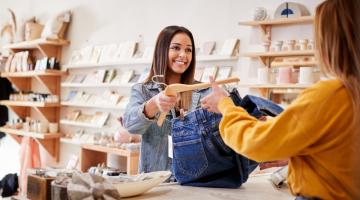
From relevant digital content that drives engagement and physical visits to constantly evolving inventory and experiences, stores like Camp, Neighborhood Goods and Studs deliver curated selections with a dose of fun and discovery.
“Curated, captivating, contemporary: A blueprint for physical stores” at NRF 2023: Retail’s Big Show was moderated by Nicole Leinbach, founder of Retail Minded. Panelists included Matt Alexander, co-founder and CEO of department store concept Neighborhood Goods; Anna Harman, co-founder and CEO of jewelry studio Studs; and Amanda Raposo, chief experience officer at experiential retailer Camp. They spoke about chasing a feeling, creating a memory and fostering magnetism.
It’s easy to go down the path of being gimmicky, Alexander said. Conversely, “we have always been of the philosophy and the belief that relevancy is the core currency that we all trade in.”
Did you miss us in NYC? Take a look at our NRF 2023: Retail's Big Show event recap.
At Neighborhood Goods, brands pay to be in the stores — there are currently three locations with a fourth on the way — but they might show up differently in the different stores. The goal is to speak to each local audience.
The product mix at Neighborhood Goods is constantly changing, with five to 10 brands introduced every Thursday, but there’s underlying consistency around people and event programming, Alexander said. It’s in the spirit of retail from “100 years ago,” where customers went to a local store and trusted its perspective, “and you went there because it was sort of changing and evolving in a way that met your local needs.”
There’s also a sense of community with on-site restaurants as well as events like concerts, conferences, live podcasts and more. The store serves as the first physical retail experience for some brands and works to capture data and test different aspects for its brands.
Raposo spoke about Camp’s two formats, some with a “magic door” that opens up to immersive, narrative-driven experiences. These ticketed events might include, for example, live musical performances, character-driven rooms and curated product tie-ins.
Those shows rotate out every four to five months, so even local families have the ability to return to an “entirely different story.” The company’s model is based on the idea of “re-engagement.” In addition to the rotating shows and special guests and experiences, each store is unique. Throughout, however, the sentiment — complete with warm “camp counselors,” a sense of joy and opportunities for engagement away from a screen — ideally remains the same.
As for Studs, the view is a bit different; with an average footprint of about 700 square feet, “we actually are trying to create much more uniform experiences in our stores,” Harman said. Similar features include an “Ear Bar” to shop for earrings, and use of neon. “The goal is for you to have an experience that feels exciting for you,” she said.
People don’t get an ear piercing to have a hole in their ear. “They’re getting an ear piercing because they’re trying to do something fun with their day,” she said. “And we really want the store and the experience that you have there to be facilitated by the team that’s there. So, everything about the physical environment, while it’s meant to be cool and fresh and feel young, it’s also meant to be just the backdrop for an amazing experience that you talk about to your friends that evening.”
The panelists each touched on finding the right footprint; Alexander notes the 10,500 square foot Neighborhood Goods in Austin, Texas — the midsized of the three — feels “tight and thoughtful.”
Raposo spoke about the importance of partnerships with organizations like Disney, Nike and Ally Bank. Camp partnered with Ally, for example, to teach kids about financial literacy by allowing them to run the store for a day. A partnership with H&M, meanwhile, focused on sustainability.
Overall, she said, there’s an ongoing pursuit for balance between “programming, play and product.” Partners have the opportunity to deliver on an unexpected experience, “an experience that will make you feel like you’re six again and will get families off the phone or off the screen to interact with your brand — and with each other — in an authentic way.” And that, ideally, is an experience worth a return trip.


